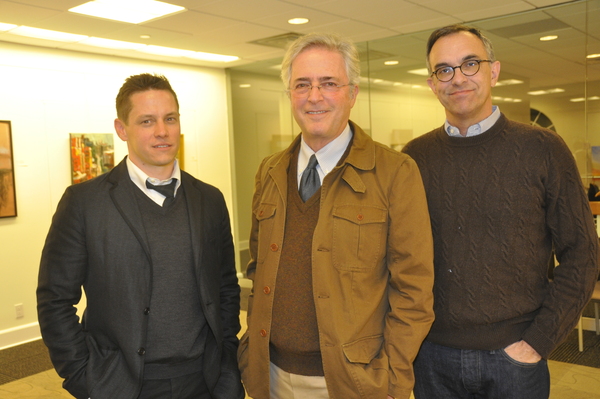
Sag Harbor-based architect Paul Masi didn’t see it coming. And neither did the three jurors—architects Mark Simon, Paul L. Whalen and Jeffery Povero—assigned to pick five winners from nearly 30 submissions that displayed architectural excellence in the American Institute of Architects Peconic Chapter’s annual awards program.
“Holy cow! It’s the third time,” said Mr. Simon upon hearing of Mr. Masi’s third win in this year’s Daniel J. Rowen Memorial Design Awards Program, run by the AIA Peconic Chapter, on Saturday night at the Southampton Cultural Center. “We didn’t know who any of the architects were ahead of time, when we were judging.”
A common thread of old-meets-new, traditional-meets-modernist ran through each of the winning projects. Mr. Masi swept the competition, snagging three of the five awards—Honor, Merit and a special jurors’ award for Economic Transformation—that celebrate excellence in the field. The two other awards—Adaptive Re-use and Economy of Means, another jurors’ award—went to Manhattan-based architect Steve Schappacher (for a Shelter Island residential project) and Riverhead-based architect Hideaki Ariizumi (for a Montauk residential project), respectively.
During a telephone interview on Sunday morning, Mr. Masi, who partners with Harry Bates at Bates Masi + Architects in Sag Harbor, said he was glad that this year’s work had paid off.
“We care a lot about what we do,” he said. “When you get the recognition, you feel some kind of reward not only from the clients, but also from your peers.”
The jurors first recognized Mr. Masi for a project in Montauk that he said was an exploration about a sense of place. The owners challenged Mr. Masi to define what Montauk is and to embody that in the architecture.
What Mr. Masi and his team created was the overall shape of a ranch house, Mr. Simon explained, but one that is “magical” and brings people through it in a “wonderful way,” he said.
“It’s a very modern house,” Mr. Simon said. “You come up to the house and it looks very traditional, and yet you’ve got all the wonders of modernity and the classiness of it.”
In the backyard, a swimming pool looks out on Lake Montauk.
“So often swimming pools are really a scar on the landscape, and here I think it really adds to it,” Mr. Simon said.
Mr. Masi’s next win—a merit award for a residence in Water Mill currently under construction—moves architecture discussion forward, according to Mr. Whalen.
“We’d love to see this house when it’s built,” Mr. Whalen said.
The creek-front property sports two buildings previously designed by architect Andrew Geller. The structures, a small house and studio, were built in 1962. Presently, they will be weaved together by elevated, wooden boardwalks that lead to a new home on the property.
“The decks were a jumping-off point, and it evolved into its own vocabulary,” Mr. Masi said. “The new architecture is not necessarily challenging the other structures. They sit on their own and this house sits on its own. There’s a subtle dialogue.”
When the judges read that the next award recipient was again Mr. Masi, none could mask the look of sheer surprise that had spread across their faces.
“This project was very interesting to us,” Mr. Povero said. “And I’m actually shocked to see it’s the same architect.”
The project, a home in Amagansett, was an interesting one for Mr. Masi, too, he said. The clients, an interior designer and a disc jockey, requested that a complete renovation of their 1960s kit house be made into a weekend retreat from their urban apartment.
The house was gutted and reduced down to the skeletal framework, Mr. Masi said. Between the existing ceiling joists, natural rope was woven through a digitally fabricated framework. Weaving patterns were used to signify different ceiling conditions and light penetrates through a crossed weave of the rope.
“What they did here was create a very memorable, very warm and unique project,” Mr. Povero explained. “In particular, they used patterns in the ceilings to create a lot of different patterns and acoustics. They really transformed the house from a nondescript, sort of cold place into an incredibly warm environment. As much as it’s the same house as it was before, it’s not. It’s a place you really want to spend time. It draws you in.”
The majority of the entries this year were modernist, residential submissions, the judges said during a reception preceding the award presentation.
“What’s interesting is that a lot of people think that if they’re going to do something really inventive and interesting that it should be modernist, and I just don’t think that’s true,” Mr. Whalen said.
“Modernism isn’t a style, despite what people claim,” Mr. Simon added. “That doesn’t make a great building.”
The key is building on what is already in the architecture world by pushing it further, the judges said. An architecture vocabulary is already set in stone; a new one can’t be invented, Mr. Whalen said.
“All five of these have their sources,” Mr. Simon said of the winning designs. “None of these are totally original, and yet all of them have little breakthroughs that make them interesting, that make them their own, what I call creatures. They still have a uniqueness to them, even though their DNA comes from very obvious places, like human beings. We all have DNA that’s from our parents, but we’re different. And we’re all whole beings, and that was true of these houses.”